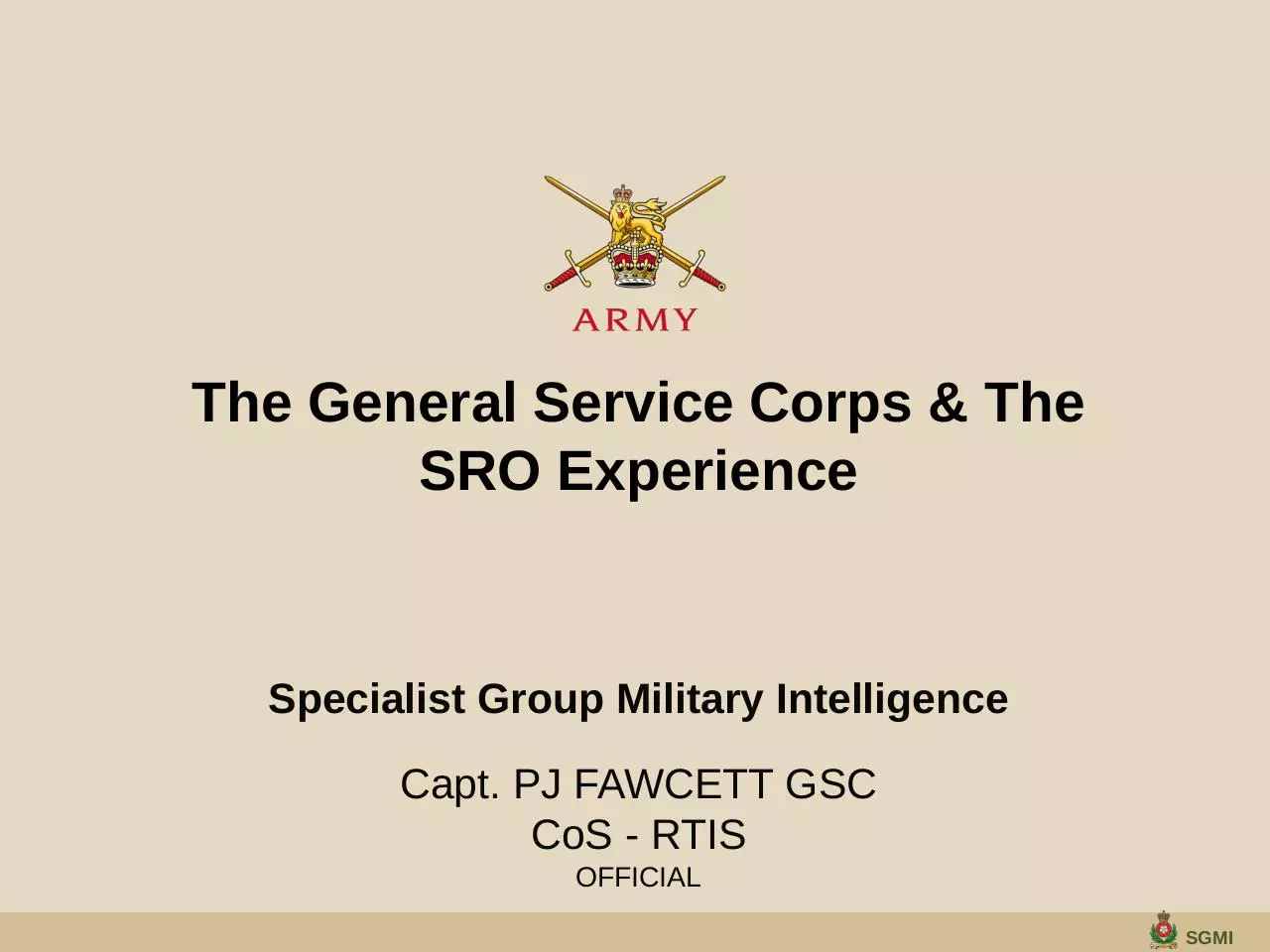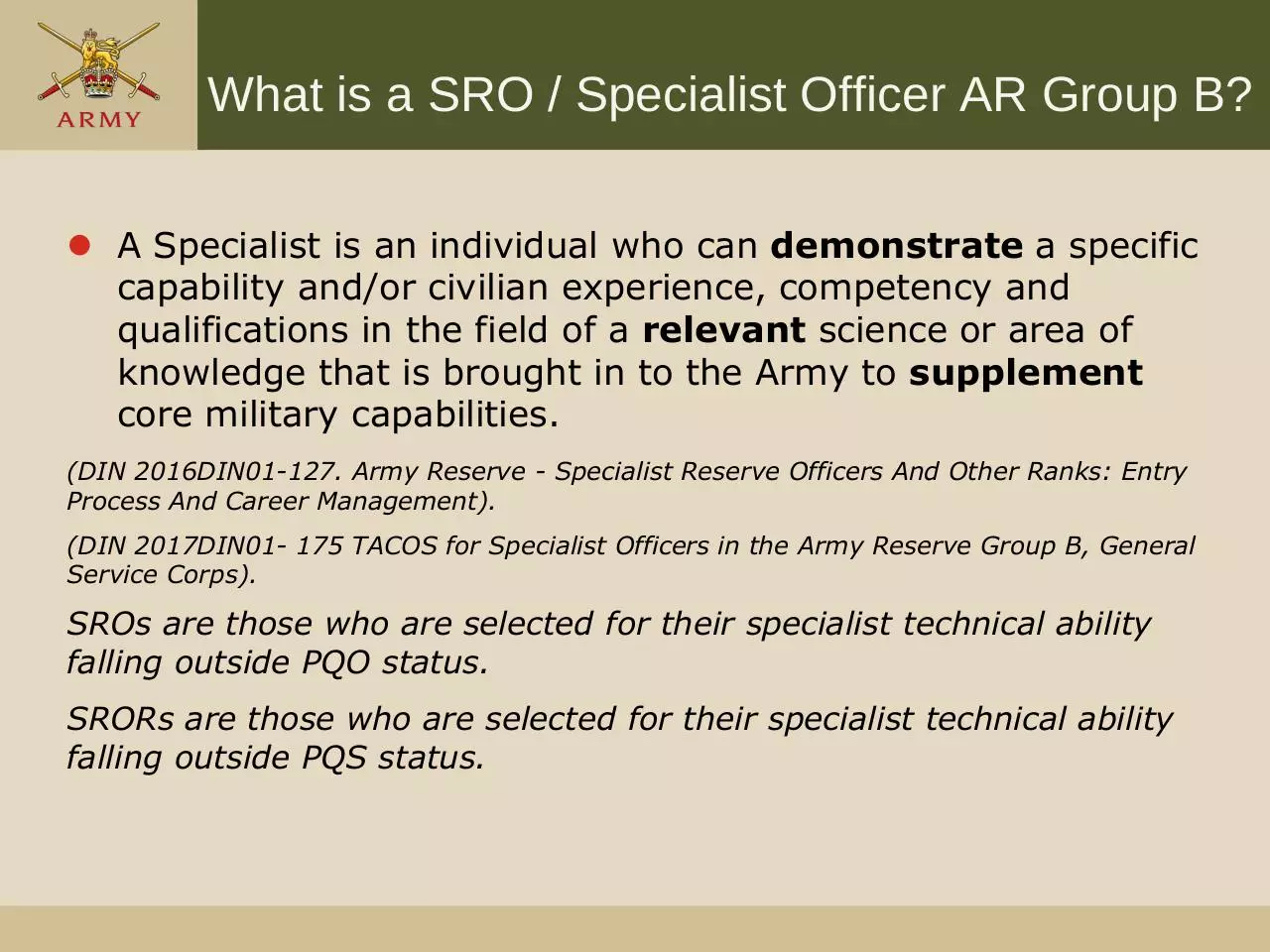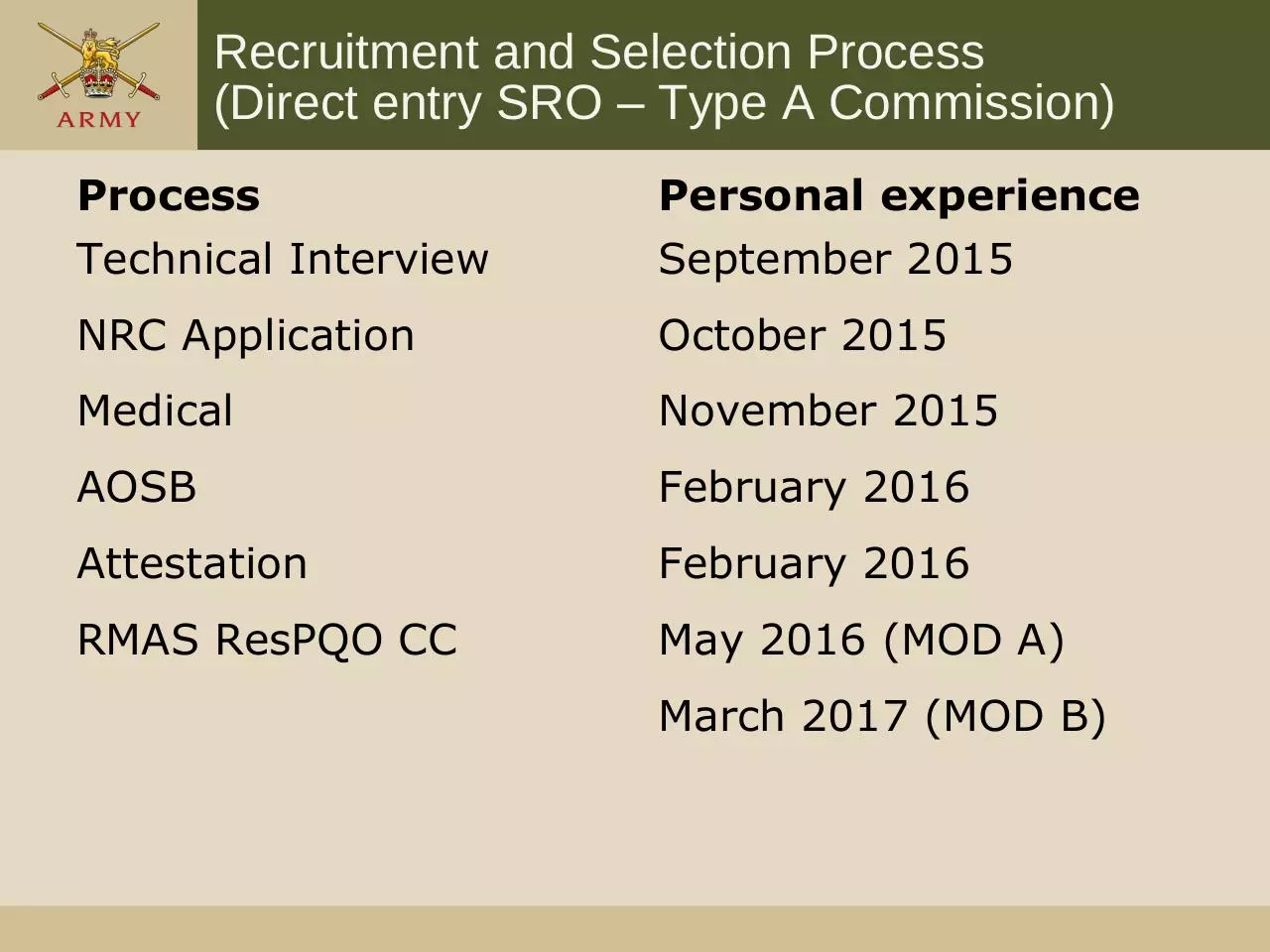20180414 RTIS FAWCETT SRO GSC Briefing 180413 (PDF)
File information
This PDF 1.5 document has been generated by , and has been sent on pdf-archive.com on 24/01/2019 at 09:37, from IP address 2.139.x.x.
The current document download page has been viewed 2302 times.
File size: 1.04 MB (16 pages).
Privacy: public file





File preview
The General Service Corps & The
SRO Experience
Specialist Group Military Intelligence
Capt. PJ FAWCETT GSC
CoS - RTIS
OFFICIAL
SGMI
Content
The role of a SRO / Specialist AR (Group B) Officer
The SRO recruitment and selection process within SGMI
Positives and Frustrations
The difference between Type A and Type B commissions
and what this means practically to SGMI
A personal view on the different skills that SRO's bring
to SGMI and to the wider Army Reserve
A short briefing on the GSC.
Q&A
What is a SRO / Specialist Officer AR Group B?
A Specialist is an individual who can demonstrate a specific
capability and/or civilian experience, competency and
qualifications in the field of a relevant science or area of
knowledge that is brought in to the Army to supplement
core military capabilities.
(DIN 2016DIN01-127. Army Reserve - Specialist Reserve Officers And Other Ranks: Entry
Process And Career Management).
(DIN 2017DIN01- 175 TACOS for Specialist Officers in the Army Reserve Group B, General
Service Corps).
SROs are those who are selected for their specialist technical ability
falling outside PQO status.
SRORs are those who are selected for their specialist technical ability
falling outside PQS status.
Examples of SRO (Group A) deployment
Unit
Cap badge
Roles
SGMI
FININT / CT / Regional
HDIS
TISO
Joint Cyber Unit
254 (SGIS) Signals Sqn
Cyber / Information
Systems & Assurance
SIB
Specialist Criminal
Investigators
77X
Various specialisations
Recruitment and Selection Process
(Direct entry SRO – Type A Commission)
Process
Technical Interview
Personal experience
September 2015
NRC Application
October 2015
Medical
November 2015
AOSB
February 2016
Attestation
February 2016
RMAS ResPQO CC
May 2016 (MOD A)
March 2017 (MOD B)
Type A (SRO) vs Type B (Neith Pillar)
Type A
Type B
RMAS (PQO) CC
Not Applicable
MATTs
Not Applicable
Fitness to MATT + RMAS
Not required
Able to deploy/mobilise
Non Deployable
Paid at AR rank
Unpaid
Min 19 days
Limited commitment
Generally DV Clearance
Clearance as required.
SME
SME
SO3 (Capt) appointments
Substantive Lt.
Promotion from OF2 to
OF4 possible (subject to
SRO TACOS)
Local OF4.
So what is so special? – a personal view.
Access to skills not normally found within the Army
SRO‟s often have significant leadership experience, gained
within their civilian jobs, that substantially exceeds that
required of their AR rank.
SRO‟s demonstrate throughout selection and training that
they are willing and able to extend out of their „comfort zone‟
SRO‟s are often to establish relationships with others (Army,
Defence, UKIC and Industry), significantly above their AR rank
“A specialist, passionately curious, challenges orthodox
thinking, a volunteer, willing to serve, a desire to make a
difference”.
The GSC – A guide for Specialist Reserve Officers 2016.
A brief guide to the General Service Corps
What is the General Service Corps?
Two disparate roles.
Primary role is an administrative holding corps for Army
personnel who have not been assigned to other units or
corps (e.g. Officer Cadets at Royal Military Academy
Sandhurst and phase one recruits at Army Training
Regiments).
Secondary role - the GSC contains personnel that are on
the General List or Special List and are usually part of the
Army Reserve.
Part of Combat Service Support (CSS) arm.
Parade far left within British Army Order of Precedence, inbetween Royal Army Physical Training Corps (RAPTC) and
QARANC.
Brief History – WW1
Set up in 1914 to meet the through put of personnel during World
War I the GSC was meant for “officers who have been gazetted to
the General List for service with Service Battalions, but whose
allocation is not included in this issue.”
In February 1915, the list was extended to include the names of
officers “who are holding other employments.”
WW2
The GSC often recruited individuals on a case-by-case basis, for vague and speculative
reasons, with many of them not knowing exactly which unit they were working with or for.
Specialist personnel under the GSC cap badge served in special duties branches,
intelligence units, and resistance organisations (such as the SOE).
All of this alludes to “classified duties which required military status but a degree of
anonymity.”
For cover purposes personnel in SOE were normally given a rank and number in one of the
three more regular services if they had none already; usually in the Army, and on the
General List. Most staff officers held army ranks, most agents were given commissions as
Lieutenants or Captains.
Notable GSC Officers
Anton Walter Freud (1921 - 2004). Grandson of the renowned
Jewish founder of psychoanalysis Sigmund Freud. Joined the
British Army and recruited by Austria Country Section of the
SOE. Served in Italy, Austria and Germany. In 1945, having
been separated from his colleagues he entered the town of
Zeltweg. Dressed in uniform and claiming to be the advance
guard of the advancing British 8th Army he demanded to take
control of the nearby airfield before the Russians arrived.
Bob Maloubier DSO MBE (1923 - 2015). French national
recruited into SOE in 1943. Founder of the French Special Forces
diving unit. Dropped into Normandy in August 1943 where he
became part of the SALESMAN network. Shot in the back in
December 1943 after trying to escape from German arrest.
Parachuted back into France June 1944, 24 hours after D-Day,
to assist the Maquis in blowing up roads and bridges to prevent
German reinforcements moving into the region. After the war
Maloubier served within France‟s counter-intelligence service in
both Africa and Indo-China.
Notable GSC Officers
Peter Lake MC (1915 – 2009) was originally commissioned
into the intelligence Corps (Field Security Police) before being
recruited into SOE. His first operation in 1942 (POSTMASTER)
was in West Africa, where he worked in the British Consulate.
In 1943 he joined the DIGGER network in France and worked
with the Macquis in the Dordogne region. Lake was made
Chevalier of the Legion d‟honneur, awarded the Croix de
Guerre and the Military Cross. In his post-war career he
worked in the Foreign Office.
John Pendlebury (1904 - 1941) was a leading archaeologist.
In 1940 he joined the SOE. After training in the UK he
returned to Heraklion with the cover of British Consul. He
spent considerable time building the resistance in Crete. When
the Germans invaded Crete in 1941 he was involved in an
attack on a German patrol and was shot in the chest. German
medical staff treated him. However, Pendlebury had lost his
dog tags and was not wearing British uniform. The following
day German paratroopers shot him following a short
interrogation. He now lies in Souda Bay Cemetery.
Crete 1941
Kronis BARKADIS
„Old Krone‟
Wearing GSC cap badge
Trusted assistant to
Capt PENDLEBURY GSC.
Pictured in 1941 in
HERAKLION just before
the German Invasion of
Crete.
Pictured with him is
SGT D BOWE of Field
Security.
Crete 1944 – Kidnap of General KREIPE
Rounds Complete
Any Questions?
Download 20180414 RTIS FAWCETT SRO GSC Briefing 180413
20180414_RTIS FAWCETT SRO GSC Briefing 180413.pdf (PDF, 1.04 MB)
Download PDF
Share this file on social networks
Link to this page
Permanent link
Use the permanent link to the download page to share your document on Facebook, Twitter, LinkedIn, or directly with a contact by e-Mail, Messenger, Whatsapp, Line..
Short link
Use the short link to share your document on Twitter or by text message (SMS)
HTML Code
Copy the following HTML code to share your document on a Website or Blog
QR Code to this page

This file has been shared publicly by a user of PDF Archive.
Document ID: 0001906584.